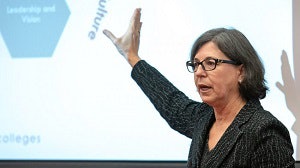As higher education institutions struggle to finish the semester amid a pandemic – and start to explore the possibility of an online fall – community colleges face their own set of financial and educational concerns about the future.
“Our learners are more vulnerable than we even imagined, [than] what the data has been telling us,” said Dr. Karen Stout, president and CEO of Achieving the Dream, a nonprofit network for community colleges focused on student success. “Faculty, with the classroom walls being shattered, have been fully exposed to understanding the student experience in brand new ways.”
 Dr. Karen Stout
Dr. Karen StoutStout spoke at a virtual town hall hosted by her organization on Monday, which offered a glimpse into the questions community college leaders are asking themselves as they respond to the coronavirus. Achieving the Dream staff members swapped best practices on screen as leaders, faculty and staff from community colleges across the country posed queries via chat box.
Many questions centered around online student supports to engage and retain diverse students.
“We know based on a rich body of research that underserved students underperform relative to their peers online,” said Susan Adams, instructional designer at Achieving the Dream. “And this is likely even more true in hastily executed remote education.”
To combat the disparities, Dr. Laurie Fladd, Achieving the Dream’s director of holistic student supports, suggested colleges invest in online mental health professionals, tutors and career advisors – but also encouraged them to think more broadly. Colleges should offer “connecting points” between students and community resources during the crisis, she said, especially for those who are food and housing insecure. Fladd also advised that schools consider providing specialized services, like an online support group for student parents.
To be effective, those resources also need to be communicated to students in a way that they’ll absorb them, said Nick Mathern, the organization’s vice president for K-12 partnerships. He finds students don’t read lengthy, information-packed emails, because they get overwhelmed, but personalized text messages with links can be more effective.
The event emphasized that the crisis is teaching colleges new, more efficient ways to examine and improve their student supports, not just in this emergency but for a post-coronavirus world.
“Colleges are eager to sustain these changes,” Stout said, referring to the academic innovation that’s blossomed out of necessity. “Can we use the lessons we’re learning to improve the student experience?”
Data might be a part of the answer, said Laurie Heacock, Achieving the Dream’s senior advisor for data and analytics. She noted that one of the advantages of a mass shift to online learning is a “robust data set” on student engagement. Colleges can track how much students are engaging with course materials and discussion boards, for example, and plan outreach accordingly to support struggling students. She also encouraged colleges to use their online tools to monitor “continuity metrics,” like retention.
Community college leaders also expressed fears about their finances.
Stout acknowledged the looming specter of state budget cuts to higher education, given the economic downturn caused by the coronavirus, and the possible “double whammy” of local cuts as well. Plus, many community colleges normally rely on funds from summer camps and other programs that use campus space, which have been canceled. She described it as a “definite challenge.”
Philanthropy could be an under-explored funding source, she said, though it presents challenges of its own. She noted that community colleges may have small foundations, but few have the resources for large-scale fundraising efforts. Still, she encouraged colleges to call on the philanthropists they do have for deeper and unrestricted investments.
Another central worry was how to plan for the fall, as colleges consider the possibility of another term of online learning.
Panelists said colleges are already considering changes like shorter terms to introduce more flexibility into the academic schedule.
Stout suggested colleges make plans for multiple scenarios, each taking into account how that scenario would impact operations.
But while anxieties surfaced about what the next academic year will bring, speakers also expressed that community colleges already possess unique strengths to weather this kind of crisis.
For example, Fladd emphasized that, while staff have had to adapt and fill more roles, most people who work at a community college are used to directly engaging with students about student supports. It’s like a “collective superpower,” she said.
For Stout, the “primary strength” of community colleges right now lies in their “localness,” their knowledge of their own communities.
“We are not without star or compass,” she said. “Our students and our communities offer us direction. And while COVID-19 is attacking our communities, it is not attacking what we do best as community colleges. This localness and this hard work toward solutions is at the heart of our current response and it will be at the heart of our recovery as a sector.”
Sara Weissman can be reached at [email protected].















